Mallory Wetherell’s porcelain cross sections of organs with delicately painted interiors may be viewed as dark or morbid by some, but her anatomic sculptures are simply a metaphor for relationships.
“I use anatomy to talk about human relationships, specifically my own relationships with loved ones or myself,” said Wetherell, assistant professor of ceramics at the University of Nebraska at Kearney. “They’re usually internalized, so I’m creating visual depictions of internalized relationships.”
Her non-traditional figurative sculptures of the interior of anatomy are a marriage between Wetherell’s love of the arts and her interest in science.
While attending the University of South Carolina, Wetherell studied biology with the intention of becoming a prosthetic designer. To be admitted into a graduate program, she took a figurative sculpture class.
“I liked the atmosphere of the art department. You walk in the art building and everyone is drinking coffee and a professor brought her five dogs to campus with her. I was like, ‘What is this crazy building on campus and how can I be a part of this community?’
“It was a totally different experience than the science lecture-based classes with 300 students and the sterile labs.”
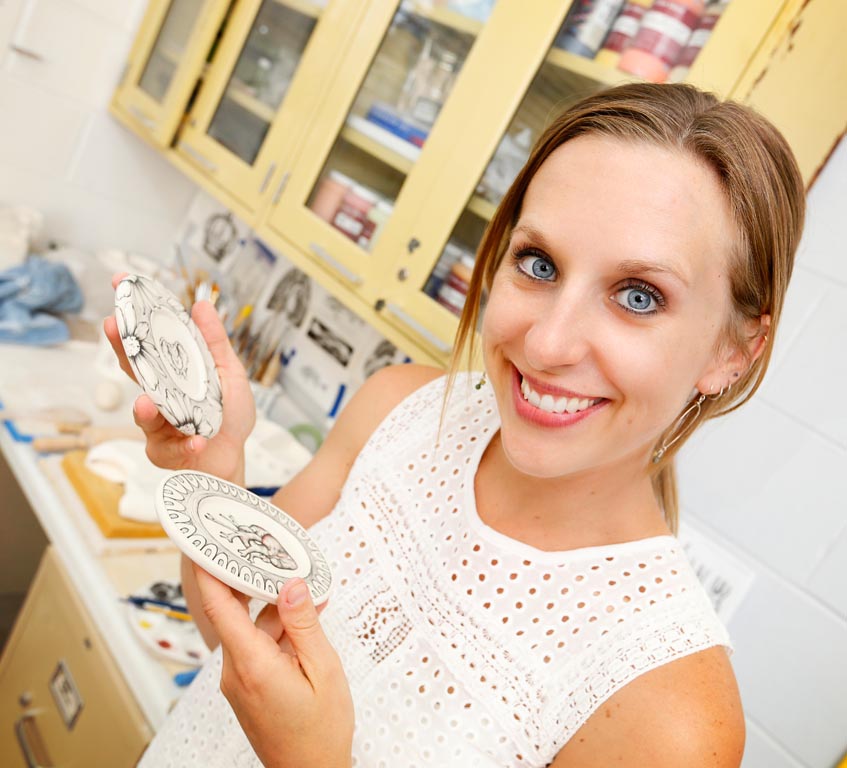 During her junior year, she changed her major to art.
During her junior year, she changed her major to art.
“I found myself flying through my organic chemistry and biology homework so that I could spend more time in the studio because that’s where I wanted to be. I had to listen to that.
“I was drawn to the world of art because it was a totally new way of thinking for me,” she said. “I had taken art in high school and always dabbled in it, but I never knew it could be a profession until I was in college.”
She fell in love with ceramics after taking an introductory ceramics course, a requirement to get into figurative sculpting class, which was required for a graduate program she hoped to be admitted to.
“I liked that ceramics was still challenging, but it was challenging to my hands as well as the mind. It was totally different from the science classes, which were mostly academic based and not physically challenging,” Wetherell said. “It was a whole different way of thinking for me. I enjoyed the act of making.”
After earning her bachelor’s degree and then her Master of Fine Arts in ceramics from the University of Massachusetts-Dartmouth, Wetherell didn’t know where to go from there.
“It’s not like you get a nursing degree and become a nurse. It’s pretty open ended. You get this art degree and it’s like ‘Welcome to the world, best of luck.’”
But her experience during graduate school curating exhibitions and pop-up shops in empty storefronts enabled her to land a job as a gallery coordinator at a Philadelphia art gallery.
The Clay Studio of Philadelphia, the largest nonprofit ceramics art organization, promotes access to the ceramic arts, at all levels of interest and proficiency, from practicing professionals to disenfranchised children of the inner city to art enthusiasts, students and collectors.
After three years at The Clay Studio, Wetherell began teaching part-time as an adjunct instructor and full-time resident artist at Tyler School of Art in Philadelphia.
She always knew that she wanted to teach, and she gained experience teaching during graduate school.
“Teaching gigs are hard to land – especially in a competitive city like Philadelphia. So you have to pay your dues and stay diligent in applying and making work. Teaching gigs in art are not only based on your teaching experience, but heavily weighted on your exhibitions and showing record. You’ve got to make your work and not lay dormant. You’ve got to keep moving and do the best to create opportunities for yourself.
“I like teaching because I like interacting with people. I love that it’s not a desk job. I like that I get to talk every day and get my hands dirty every day. Thinking creatively and problem solving is something we learn to not do. We’re all born creative and then we grow out of it. The real world happens, and we lose that. I get to reintroduce creativity.”
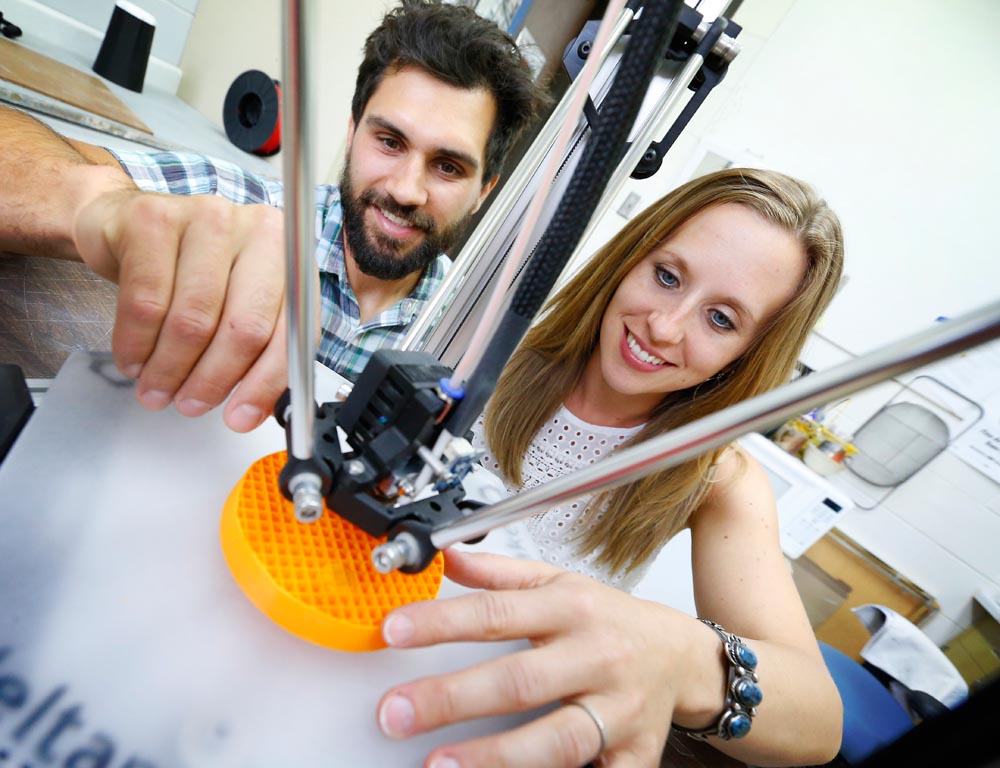
ORGANS, ANATOMY, ART
Wetherell’s creative inspiration comes from her fascination and fear of the human body’s complexity and her desire to expose aspects of relationships that aren’t readily apparent.
“Each piece is a visual depiction of an internalized relationship that I have with myself, or that I share with those individuals closest to me. With each piece, I use emotional associations linked to various anatomies of the human body – the gut as a metaphor for raw instinctual emotion, a lung to express the need for air. I then manipulate these cellular tissues, organs, and overall system structures in order to explore specific and personal relationships. The finished work is graphic in nature, a combination of sculpted porcelain and detailed underglaze renderings, referencing 18th century medical illustrations and traditional commemorative blue and white ware,” Wetherell writes in her artist statement.
Her porcelain cross sections of organs and anatomy are delicately painted. What Wetherell refers to as “heavy handed, obsessive work.”
“A lot of people see my work as dark and creepy, but I don’t see it that way at all. I do see that they could be viewed as a little bit macabre, so I like to add botanical elements to beautify it in a way. The flower serves as a metaphor for life and death. It’s shown in different stages,” she said.
While her work has been scaled down since the birth of her daughter, Corinne, in August 2014, Wetherell is still exploring relationships through anatomical pieces. Her newest piece, “Shared Space,” is a scaled-down version of a cross section of a two-fused heart. Her original – “Cross-Section: heart” – was completed in 2013. The new piece features much tighter detail, she said.
“My work is really challenging me right now,” she said.
Her pieces have been featured in nearly 50 exhibitions from Rhode Island to Montana to Texas to Massachusetts.
In 2015, her exhibitions included “Small Favors” at The Clay Studio, “Side by Side: Mallory Wetherell and Matt Ziemke” at the Arch Contemporary Ceramics Gallery in Tiverton, R.I., “All About Porcelain” in Missoula, Mont., and “Drawn Drawing” at Bridgewater State (Mass.) University.
INTRODUCING TECHNOLOGY
Wetherell recently started exploring 3D printing.
A $3,000 grant from the Research Services Council at UNK allowed her to purchase a DeltaMaker 3D Printer. She plans to convert the printer to print in ceramic slip – or liquid clay.
A 3D printer lays down successive layers of material until an object is created. So far, Wetherell has been experimenting with using the plastic 3D prints to use as positives to create plaster molds. Once the plaster mold is dry, she removes the plastic printed object, creating a negative space in the mold. She then pours ceramic slip into the mold, creating a casted object that she manipulates and fires in the kiln.
“You can’t just say print a flower. You have to use a computer program to create files that will be printed. There’s a learning curve,” she said. “My work is organic and graphic. With this, it’s more geometric. I’m still in the learning stage in figuring out how to get it from a file to an actual object.”
Her anatomical pieces and 3D printed pieces are currently two bodies of work, but she hopes to eventually merge them.
“I want to be on the forefront in my field. It’s just a whole different way of making. I like the idea of making multiples. My own work takes so long – it is super detailed and it takes a while with sanding and painting. It’d be great if I could work in multiples.”
When she becomes more comfortable with 3D printing, Wetherell hopes to introduce the technology to her art students in an alternative methods and materials ceramics class or 3D ceramics class.
Wetherell’s teaching philosophy is simply to make art fun.
“Art is meant to bring a breath of fresh air. It’s a crucial part of society, but a lot of times it’s an overlooked part of society,” she said. “I want my students to come in and recognize that they’re probably not going to be famous artists, but I want them to think creatively and problem-solve.
“Students often ask, ‘What do you want me to make for you?’ They’re not making it for me. They’re making it for themselves. Sometimes they don’t know what to do with that creative freedom. I help them learn to be creative and trust their instincts.”
Coming to UNK wasn’t an easy decision for Wetherell.
She was working as an adjunct professor and visiting artist at Indiana University Southeast in New Albany, Ind., where her husband, Matt Ziemke, was also an adjunct professor and visiting artist.
“When I came out here to interview, I thought it was isolated. I am used to being on a coast, and (in Kearney) we are equal distances from both coasts. But everybody was so nice.”
Meeting Victoria Goro-Rapoport, assistant professor of printmaking and drawing, made the job appealing.
“Looking at her work and her track record, I saw that she could go anywhere. There’s a reason she’s here. That was reassuring. There seemed like a lot of opportunities at UNK,” Wetherell said.
Goro-Rapoport said she is drawn to the delicate, and intimate, quality of Wetherell’s porcelain sculptures.
“Every single one of them is a little gem, beautifully crafted and intricately painted. … It takes real courage, dedication and determination to deliberately go in a different direction; to slow down and invest one’s time and attention into delicate and elaborate pieces,” said Goro-Rapoport.
“I believe that these qualities of patience and dedication, that are so present in Mallory’s personal work, are the most valuable assets the students can learn from her in a classroom.”
Wetherell’s background in science proves very useful in the so-called “artistic” classroom environment, said Goro-Rapoport.
“Quite often beginner students’ expectations are tainted by the idea that art should be all fun, devoid of hard thought and boring labor. Mallory’s work proves that art, just like science, is a thought process and hard work, and one cannot expect an instantaneous result.”
Doug Waterfield, chair of the Department of Art and Art History, said Wetherell’s enthusiasm in the classroom is infectious.
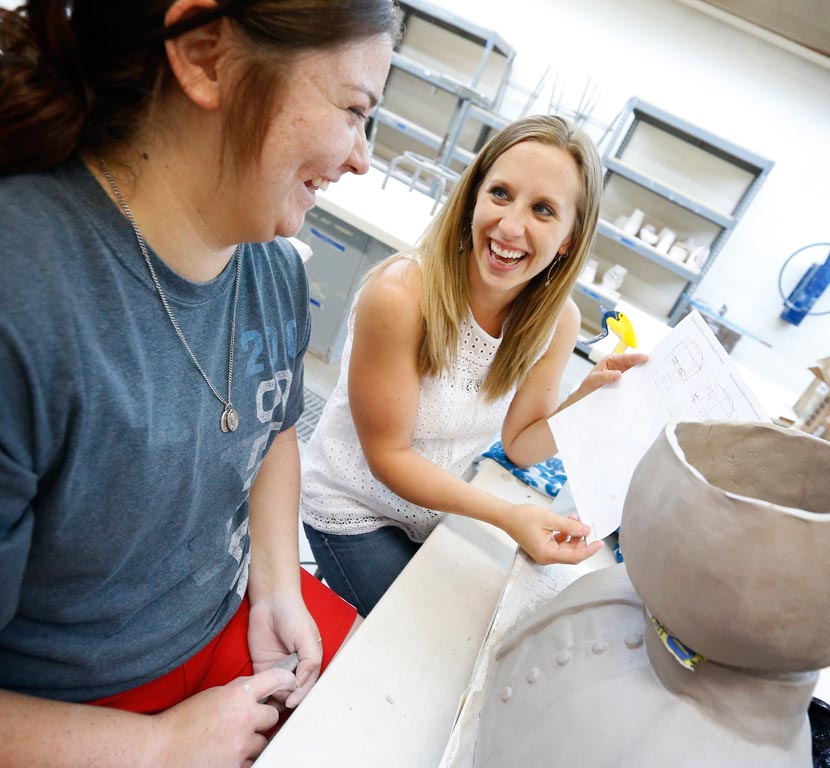 “Students actually listen to her and want to hear what she has to say. She has a unique ability to relate to, engage and inspire students within the medium of clay,” he said. “Her own work supports this attitude. It’s insightful, technically flawless and inventive. I can honestly say that I haven’t viewed human organs the same way since becoming acquainted with her work.”
“Students actually listen to her and want to hear what she has to say. She has a unique ability to relate to, engage and inspire students within the medium of clay,” he said. “Her own work supports this attitude. It’s insightful, technically flawless and inventive. I can honestly say that I haven’t viewed human organs the same way since becoming acquainted with her work.”
Wetherell is working to grow interest in a UNK ceramics program that was no longer growing. She resurrected the ceramics club called Clay Works, which had two pottery sales during the 2014-15 academic year.
She also organized a Raku workshop. Raku is a firing process developed in 16th century Japan for Japanese tea ceremonies. Pieces are glazed, dried and put into a kiln until the glazes have melted. The piece is then removed and placed into a nest of hay or newspaper and covered with a bucket, creating a reduction chamber. The reduction creates lustrous and crackle glazes.
“I like a challenge. It’s nice to have academic freedom. I get to make the classes I want, and I don’t have somebody leaning over my shoulder. The department really trusts that they hired you for a reason, and that’s refreshing,” said Wetherell, who also hopes to increase the number of students majoring in ceramics.
To further encourage students to explore art and ceramics, Wetherell proposed a class for the summer of 2016 in which students will travel to New York City to learn about art and art history.
“A lot of my students are not going to go on to become ceramic artists. My job is to instill an appreciation of the arts, and also teach them to think creatively.”
In her short time at UNK, Wetherell’s artwork has quickly gained the attention of students and colleagues, as well as national publications. Mallory and her husband, Matt, a part-time lecturer in ceramics and sculpture at UNK, were selected as two of 16 emerging artists to watch in 2015 by Ceramics Monthly magazine. They were featured in the May edition and selected from more than 300 submissions.
“Mallory is not only a presence to be reckoned with in the classroom, but she attacks her own work with a ferocity and dedication that is matched by few,” Waterfield said. “She is an intelligent, professionally active and thoughtful colleague. Her opinions on improving not only the ceramics program, but the department as a whole, have been invaluable.”
Mallory Wetherell
Title: Assistant Professor of Ceramics
College: Fine Arts and Humanities
Education: Bachelor of Fine Arts, University of South Carolina, 2006; Master of Fine Arts, University of Massachusetts-Dartmouth, 2010.
Years at UNK: 1
Career: Adjunct instructor and visiting artist, Indiana University Southeast; 2013-14; Adjunct instructor and visiting artist, Tyler School of Art, Philadelphia, 2013; Resident artist, Archie Bray Foundation, Helena, Mont., 2013; Gallery coordinator, The Clay Studio, Philadelphia, 2010-13
Family: Husband, Matt Ziemke, part-time lecturer in ceramics and sculpture at UNK. Daughter, Corinne, 1.
Hobbies/Interests: Working in art studio, Dogs Paloma and Charlotte, Travel, Gardening, Camping, Backpacking, Dining.
Honors/Awards: 2014 Research Services Council seed grant recipient for project “DeltaMaker 3D Printing in Ceramic.” Wetherell modified a 3D printer so that it can print in clay.
Areas of research/specialization: Contemporary ceramic sculpture, china painting and drawing.
Courses taught: Ceramics: Handbuilding, Wheel Throwing, Mold Making; Sculpture, Art Appreciation, Drawing, 3D Design.
Recent Selected Exhibitions:
- “Uncommon Object,” Star Store Gallery, New Bedford, Mass., 2015.
- “Side by Side: Mallory Wetherell & Matt Ziemke,” Arch Contemporary Ceramics Gallery, Tiverton, R.I., 2015.
- “Drawn Drawing,” Bridgewater State University, 2015.
- “All About Porcelain,” The Clay Studio, Missoula, Mont., 2015.
- “Small Favors,” The Clay Studio, Missoula, Mont., 2015.
- “Mallory Wetherell and Heesoo Lee,” Schacht Gallery, Saratoga, N.Y., 2014.
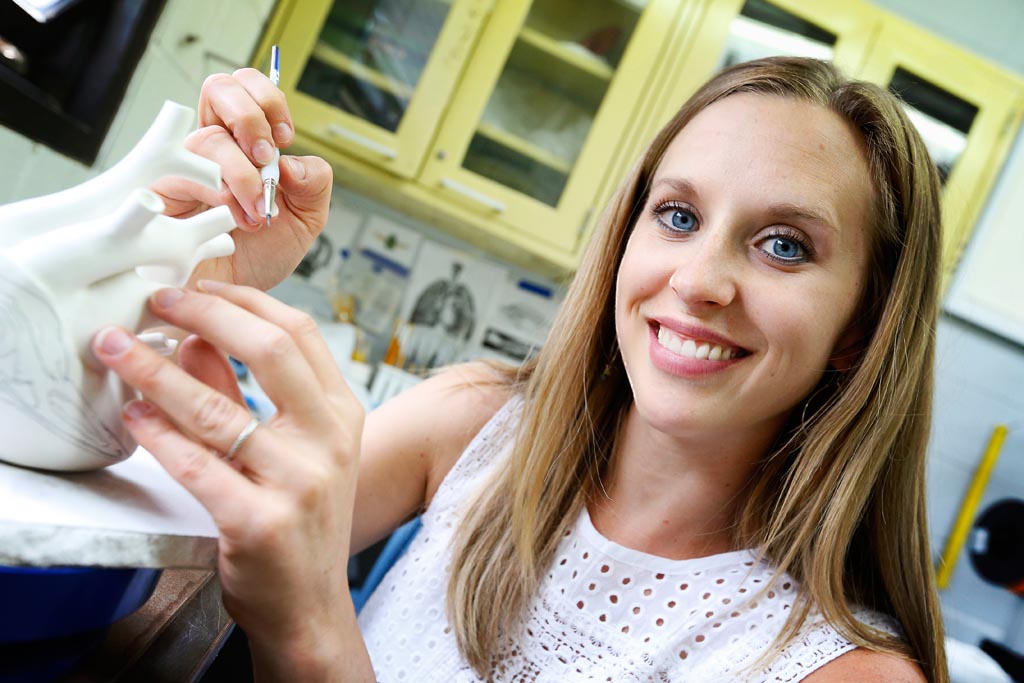
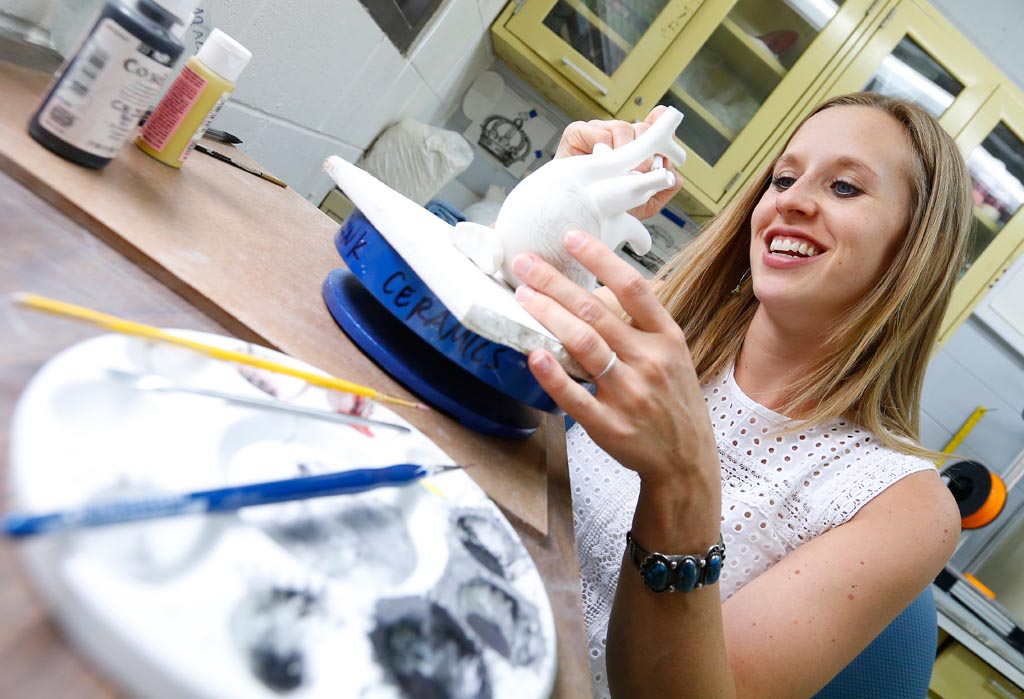
thanks for sharing this story about Wetherell, and her journey to become the ceramics lecturer at UNK. I really like that she realized how ceramics was a whole new way of thinking from more traditional science. In fact, it sounds like it would be a good idea for scientists to stretch their brains by doing more creative activities like this. It could really expand their horizons!